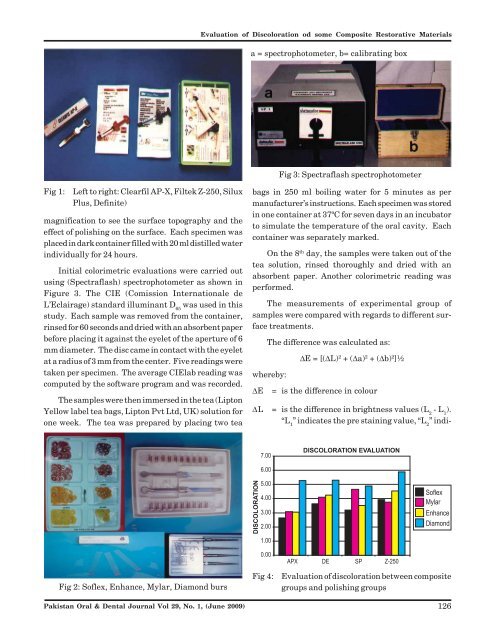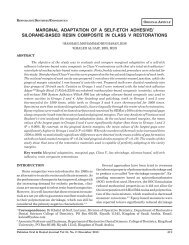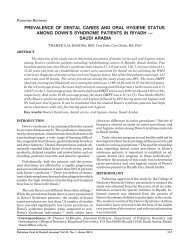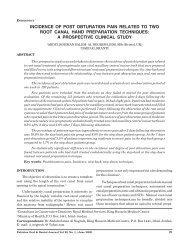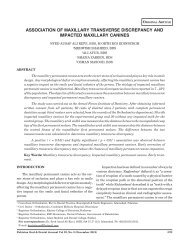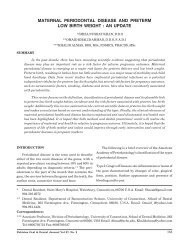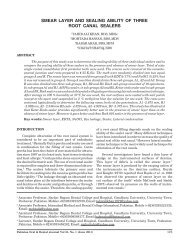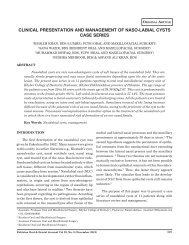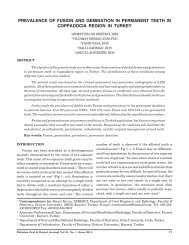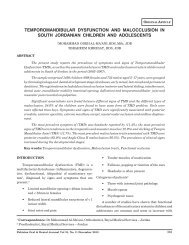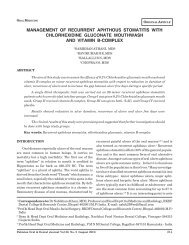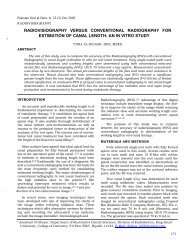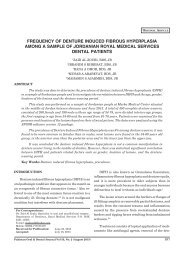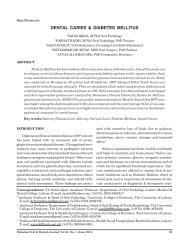Evaluation of Discolouration of Some Composite Restorative Materials
Evaluation of Discolouration of Some Composite Restorative Materials
Evaluation of Discolouration of Some Composite Restorative Materials
Create successful ePaper yourself
Turn your PDF publications into a flip-book with our unique Google optimized e-Paper software.
<strong>Evaluation</strong> <strong>of</strong> Discoloration od some <strong>Composite</strong> <strong>Restorative</strong> <strong>Materials</strong><br />
a = spectrophotometer, b= calibrating box<br />
Fig 3: Spectraflash spectrophotometer<br />
Fig 1:<br />
Left to right: Clearfil AP-X, Filtek Z-250, Silux<br />
Plus, Definite)<br />
magnification to see the surface topography and the<br />
effect <strong>of</strong> polishing on the surface. Each specimen was<br />
placed in dark container filled with 20 ml distilled water<br />
individually for 24 hours.<br />
Initial colorimetric evaluations were carried out<br />
using (Spectraflash) spectrophotometer as shown in<br />
Figure 3. The CIE (Comission Internationale de<br />
L’Eclairage) standard illuminant D 65<br />
was used in this<br />
study. Each sample was removed from the container,<br />
rinsed for 60 seconds and dried with an absorbent paper<br />
before placing it against the eyelet <strong>of</strong> the aperture <strong>of</strong> 6<br />
mm diameter. The disc came in contact with the eyelet<br />
at a radius <strong>of</strong> 3 mm from the center. Five readings were<br />
taken per specimen. The average CIElab reading was<br />
computed by the s<strong>of</strong>tware program and was recorded.<br />
The samples were then immersed in the tea (Lipton<br />
Yellow label tea bags, Lipton Pvt Ltd, UK) solution for<br />
one week. The tea was prepared by placing two tea<br />
bags in 250 ml boiling water for 5 minutes as per<br />
manufacturer’s instructions. Each specimen was stored<br />
in one container at 37ºC for seven days in an incubator<br />
to simulate the temperature <strong>of</strong> the oral cavity. Each<br />
container was separately marked.<br />
On the 8 th day, the samples were taken out <strong>of</strong> the<br />
tea solution, rinsed thoroughly and dried with an<br />
absorbent paper. Another colorimetric reading was<br />
performed.<br />
The measurements <strong>of</strong> experimental group <strong>of</strong><br />
samples were compared with regards to different surface<br />
treatments.<br />
The difference was calculated as:<br />
whereby:<br />
ΔE<br />
ΔE = [(ΔL) 2 + (Δa) 2 + (Δb) 2 ]½<br />
= is the difference in colour<br />
ΔL = is the difference in brightness values (L 2<br />
- L 1<br />
).<br />
“L 1<br />
” indicates the pre staining value, “L 2<br />
” indi-<br />
7.00<br />
DISCOLORATION EVALUATION<br />
DISCOLORATION<br />
6.00<br />
5.00<br />
4.00<br />
3.00<br />
2.00<br />
1.00<br />
S<strong>of</strong>lex<br />
Mylar<br />
Enhance<br />
Diamond<br />
Fig 2: S<strong>of</strong>lex, Enhance, Mylar, Diamond burs<br />
Pakistan Oral & Dental Journal Vol 29, No. 1, (June 2009)<br />
0.00<br />
Fig 4:<br />
APX DE SP Z-250<br />
<strong>Evaluation</strong> <strong>of</strong> discoloration between composite<br />
groups and polishing groups<br />
126


